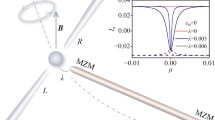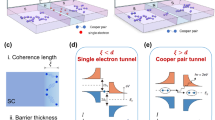Abstract.
We have investigated the mesoscopic transport through the system with a quantum dot (QD) side-coupled to a toroidal carbon nanotube (TCN) in the presence of spin-flip effect. The coupled QD contributes to the mesoscopic transport significantly through adjusting the gate voltage and Zeeman field applied to the QD. The compound TCN-QD microstructure is related to the separate subsystems, the applied external magnetic fields, as well as the combination of subsystems. The spin current component Izs is independent on time, while the spin current components Ixs and Iys evolve with time sinusoidally. The rotating magnetic field induces novel levels due to the spin splitting and photon absorption procedures. The suppression and enhancement of resonant peaks, and semiconductor-metal phase transition are observed by studying the differential conductance through tuning the source-drain bias and photon energy. The magnetic flux induces Aharonov-Bohm oscillation, and it controls the tunnelling behavior due to adjusting the flux. The Fano type of multi-resonant behaviors are displayed in the conductance structures by adjusting the gate voltage Vg and the Zeeman field \(\bf B\rm_2\) applied to the QD.
Similar content being viewed by others
References
K. Tsukagoshi, B.W. Alphenaar, H. Ago, Nature (London) 401, 572 (1999)
A.F. Morpurgo, J. Kong, C.M. Marcus, H. Dai, Science 286, 263 (1999)
H. Mehrez, J. Taylor, H. Guo, J. Wang, C. Roland, Phys. Rev. Lett. 84, 2682 (2000)
B.I. Dunlap, Phys. Rev. B 46, 1933 (1992)
S. Itoh, S. Ihara, J. Kitakami, Phys. Rev. B 47, 1703 (1993); S. Itoh, S. Ihara, J. Kitakami, Phys. Rev. B 47, 12908 (1993)
R.C. Haddon, Nature (London) 388, 31 (1997)
R. Martel, H.R. Shea, Ph. Avouris, Nature (London) 398, 299 (1999); H.R. Shea, R. Martel, Ph. Avouris, Phys. Rev. Lett. 84, 4441 (2000)
M.F. Lin, D.S. Chuu, Phys. Rev. B 57, 6731 (1998); R. Saito, G. Dresselhaus, M.S. Dresselhaus, Physical Properties of Carbon Nanotubes (Imperial College Press, London, 1998)
H.K. Zhao, Phys. Lett. A 310, 207 (2003); H.K. Zhao, Phys. Lett. A 317, 329 (2003)
H.K. Zhao, Phys. Lett. A 308, 226 (2003); H.K. Zhao, Eur. Phys. J. B 33, 365 (2003)
H.K. Zhao, J. Wang, Phys. Lett. A 325, 285 (2004); H.K. Zhao, J. Wang, Eur. Phys. J. B 40, 93 (2004)
S. Datta, B. Das, Appl. Phys. Lett. 56, 665 (1990)
S.A. Wolf et al., Science 294, 1488 (2001); R. Fiederling et al., Nature (London) 402, 787 (1999)
G.A. Prinz, Science 282, 1660 (1998); Y. Ohno et al., Nature (London) 402, 790 (1999)
A. Brataas, Y. Tserkovnyak, G.E.W. Bauer, B. Halperin, Phys. Rev. B 66, 060404 (2002)
Q.F. Sun, H. Guo, J. Wang, Phys. Rev. Lett. 90, 25830 (2003)
B. Wang, J. Wang, H. Guo, Phys. Rev. B 67, 092408 (2003)
H.K. Zhao, J. Wang, Eur. Phys. J. B 44, 93 (2005)
H.K. Zhao, Q. Wang, Phys. Lett. A 338, 425 (2005)
H.K. Zhao, L.N. Zhao, Eur. Phys. J. B 47, 295 (2005)
M. Büttiker, C.A. Stafford, Phys. Rev. Lett. 76, 495 (1996)
P. Zhang, Q.K. Xie, X.C. Xie, Phys. Rev. Lett. 91, 196602 (2003)
T. Ando, Semicond. Sci. Technol. 15, R13 (2000)
A.P. Jauho, N.S. Wingreen, Y. Meir, Phys. Rev. B 50, 5528 (1994)
H.K. Zhao, Z. Phys. B 102, 415 (1997); H.K. Zhao, Phys. Lett. A 226, 105 (1997); H.K. Zhao, Phys. Rev. B 63, 205327 (2001)
J.P. Lu, Phys. Rev. Lett. 74, 1123 (1995)
Author information
Authors and Affiliations
Corresponding author
Rights and permissions
About this article
Cite this article
Zhao, HK., Wang, J. & Wang, Q. Charge and spin currents tunnelling through a toroidal carbon nanotube side-coupled with a quantum dot. Eur. Phys. J. B 51, 425–433 (2006). https://doi.org/10.1140/epjb/e2006-00245-3
Received:
Published:
Issue Date:
DOI: https://doi.org/10.1140/epjb/e2006-00245-3




